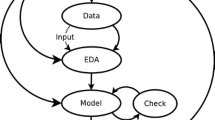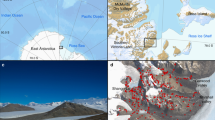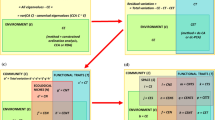Abstract
We present an adaptation of existing variance partitioning methods todecompose species-environment relationships in hierarchically-structured,multi-scaled data sets. The approach translates a hierarchical, multi-scaleconceptual model into a statistical decomposition of variance. It uses a seriesof partial canonical ordinations to divide the explained variance inspecies-environment relationships into its independent and confoundedcomponents, facilitating tests of the relative importance of factors atdifferent organizational levels in driving system behavior. We discuss themethod in the context of an empirical example based on forest bird communityresponses to multiple habitat scales in the Oregon Coast Range, USA. Theexamplepresents a two-tiered decomposition of the variation in the bird community thatis explainable by a series of habitat factors nested within three spatialscales(plot, patch, and landscape). This method is particularly suited for theproblems of hierarchically structured landscape data. The explicit multi-scaleapproach is a major step forward from conducting separate analyses at differentscale levels, as it allows comprehensive analysis of the interaction of factorsacross scales and facilitates ecological interpretation in theoretical terms.
Similar content being viewed by others
References
Allen T.F.H. and Starr T.B. 1982. Hierarchy: Perspectives for Ecological Complexity. University of Chicago Press, Chicago, Illinois, USA.
Anderson M.J. and Gribble N.A. 1998. Partitioning the variation among spatial, temporal and environmental components in a multivariate data set. Australian Journal of Ecology 23: 158–167.
Anderson M.J. and Legendre P. 1999. An empirical comparison of permtuation methods for tests of partial regression coefficients in a linear model. J. Stat. Comput. Sim. 62: 271–303.
Borcard D. and Legendre P. 1994. Environmental control and spatial structure in ecological communities: an example using oribatid mites (Acari, Orbiatei). Environ. Ecol. Stat. 1: 37–53.
Borcard D., Legendre P. and Drapeau P. 1992. Partialling out the spatial component of ecological variation. Ecology 73: 1045–1055.
Kotliar N.B. and Wiens J.A. 1990. Multiple scales of patchiness and patch structure: a hierarchical framework for the study of heterogeneity. Oikos 59: 253–260.
Legendre P. and Borcard D. 1994. Rejoiner. Environ. Ecol. Stat. 1: 57–61.
Legendre P. and Legendre L. 1998. Numerical Ecology. 2nd edn. Elsevier, Amsterdam, The Netherlands.
Liu Q.H. and Brakenhielm S. 1995. A statistical approach to decompose ecological variation. Water, Air, and Soil Pollution 1–4: 61–87.
McGarigal K. and Cushman S.A. 2002. Comparative evaluation of experimental approaches to the study of habitat fragmentation effects. Ecological Applications.
McGarigal K., Cushman S.A. and Stafford S. 2000. Multivariate Statistics for Wildlife and Ecology Research. Springer Verlag, New York, New York, USA.
McGarigal K. and Marks B.J. 1995. FRAGSTATS: spatial pattern analysis program for quantifying landscape structure. Gen. Tech. Rep. PNW-GTR-351., Portland, Oregon, USA.
McGarigal K. and McComb W.C. 1995. Relationships between landscape structure and breeding birds in the Oregon Coast Range. Ecological Monographs 65: 235–260.
O’Neill R.V., DeAngelis D.L., Waide J.B. and Allen T.F.H. 1986. A Hierarchical Concept of Ecosystems. Princeton University Press, Princeton, New Jersy, USA.
Schneider D.C. 1994. Quantitative Ecology: Spatial and Temporal Scaling. Academic Press, San Diego, California, USA.
ter Braak C.J.F. 1986. Canonical correspondence analysis: a new eigenvector technique for multivariate direct gradient analysis. Ecology 67: 1167–1179.
ter Braak C.J.F. 1987. The analysis of vegetation-environment relationships by canonical correspondence analysis. Vegetatio 75: 159–160.
ter Braak C.J.F. 1988. Partial canonical correspondence analysis. In: Bock H.H. (ed.), Classification and Related Methods of Data Analysis., Amsterdam, North-Holland, The Netherlands, pp. 551–558.
ter Braak C.J.F. 1992. Permutation vs. bootstrap significance tests in multiple regression and ANOVA. In: Jockel K.H., Rothe G. and Sendler W. (eds), Bootstrapping and Related Techniques. Springer-Verlag, Berlin, Germany, pp. 79–85.
ter Braak C.J.F. and Prentice I.C. 1988. A theory of gradient analysis. Adv. Ecol. Res. 18: 271–317.
ter Braak C.J.F. and Smilauer P. 1998. CANOCO Reference Manual and User’s Guide to Canoco for Windows: Software for Canonical Community Ordination (Version 4). Microcomputer Power, Ithaca, New York, USA.
Wiens J.A. 1989. Spatial scaling in ecology. Functional Ecology 3: 385–397.
Whittaker J. 1984. Model interpretation from the additive elements of the likelihood function. Appl. Statistics 33: 52–64.
Author information
Authors and Affiliations
Rights and permissions
About this article
Cite this article
Cushman, S.A., McGarigal, K. Hierarchical, Multi-scale decomposition of species-environment relationships. Landscape Ecol 17, 637–646 (2002). https://doi.org/10.1023/A:1021571603605
Issue Date:
DOI: https://doi.org/10.1023/A:1021571603605




